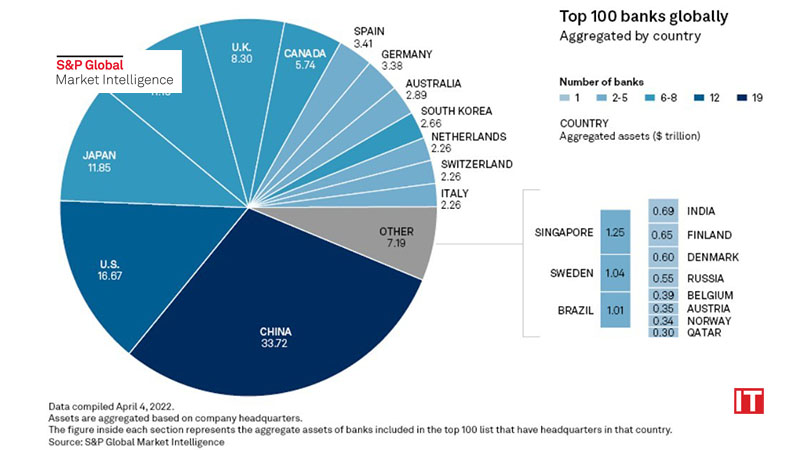European banks lost some of their dominance in global asset size rankings in 2021, while major Chinese lenders maintained their lead as the world’s biggest financial institutions, according to the Global Bank Rankings published by S&P Global Market Intelligence, an annual ranking of the 100 largest banks in the world in terms of total assets.
Twenty-six of the 37 European lenders on the list of the world’s 100 largest banks slid down the rankings by between one and nine notches as of 2021-end from a year ago. The total assets of all European banks on the list contracted 2.16% to $36.9 trillion in 2021 from $37.7 trillion a year earlier.
“European lenders saw their balance sheets shrink as their home markets offered slower economic growth relative to the rest of the world. Several European lenders also scaled back their stateside operations after facing strong competition from major U.S. lenders,” said Nathan Stovall, Principal Analyst at S&P Global Market Intelligence.
Spain’s Banco Bilbao Vizcaya Argentaria SA, for instance, slid one place to No. 47 after selling a 639-branch business in the U.S. with almost $103 billion in total assets. HSBC Holdings PLC, however, maintained its position at No. 8 as its pivot to Asia’s wealth management business helped offset the impact of the sale of its retail banking operations in the U.S. and France.
Meanwhile, major Chinese banks – Industrial & Commercial Bank of China Ltd., China Construction Bank Corp., Agricultural Bank of China Ltd. and Bank of China Ltd. – kept their top four positions with an expanded balance sheet, widening their lead over most other banks in the world.
“Beijing has been pushing banks to lend more to infrastructure projects and small businesses while cutting key interest rates to free up more liquidity for lending,” Stovall said. “The policy goal was to speed up economic recovery, which started slowing again in the second half of 2021 amid a wave of bond defaults by property developers.”
Major U.S. banks, such as JPMorgan Chase & Co., Bank of America Corp. and The Goldman Sachs Group Inc., saw an expansion in their balance sheets in 2021, pushing their asset size rankings higher. JPMorgan and Bank of America moved up the ranks by one and two notches to No. 5 and No. 7, respectively.
“Government efforts to mitigate the economic impact of the pandemic flooded the markets with liquidity and inflated U.S. bank balance sheets,” Stovall said. “The absence of government stimulus and the Fed’s efforts to combat elevated inflation, including through the reduction of its $9 trillion balance sheet, will lead to slower balance sheet growth in the future.”
Regional rankings from the Global Bank Rankings series covering the U.S., Europe, Asia-Pacific, Latin America & Caribbean, and African and the Middle East will also be available in the coming weeks.
About S&P Global Market Intelligence
At S&P Global Market Intelligence, we understand the importance of accurate, deep and insightful information. We integrate financial and industry data, research and news into tools that help track performance, generate alpha, identify investment ideas, perform valuations and assess credit risk.


































